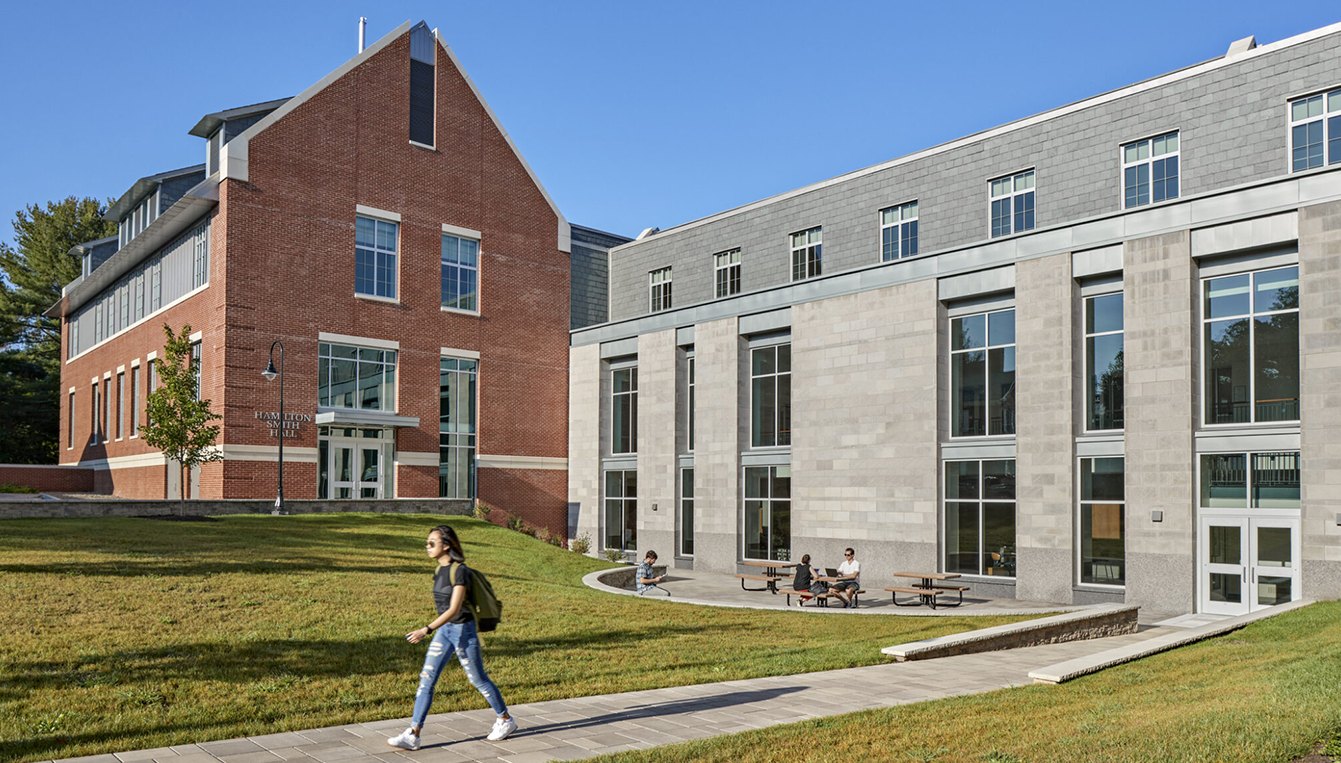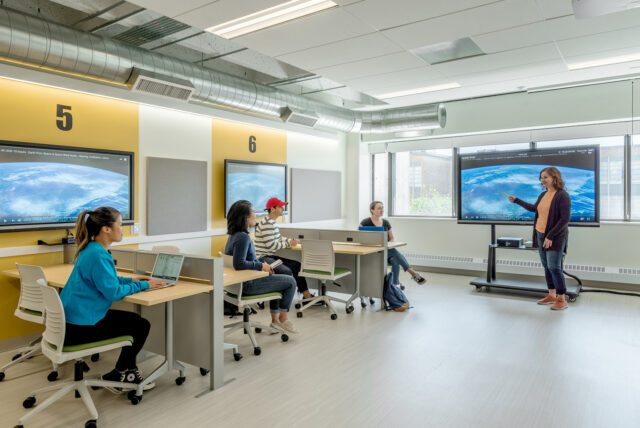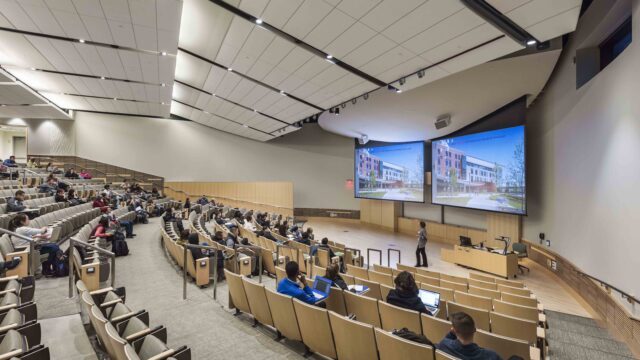Benjamin Markham
President

Colleges and universities across the country are making plans for a fall semester that may be different than any before. Some have announced plans to open their campuses to students – with safety precautions in place – while others have announced plans for an online-only fall. Many universities may seek a middle ground: a hybrid approach with some students in classrooms and lecture halls on campus, and others participating remotely. Imagine a classroom conversation in a college seminar, with multiple students discussing the topic at hand along with the instructor, when half of those students are online. This scenario raises some unique acoustical and technological challenges: how to outfit a classroom so that students in the classroom can hear well during a class discussion – socially distanced 6 or more feet apart from one another – while simultaneously enabling online participation.
Acentech is no stranger to online learning. The class I taught this semester – in MIT’s architecture department – transitioned to an online format in March; the same is true for my colleague Nicole Cuff’s class at Roger Williams and the Tufts class taught by my colleague Kelsey Rogers. Another colleague, Marielle Frederick, finished her degree at the Boston Architectural College online this month. And for years, we’ve been designing acoustics and technology solutions for lecture capture and for remote learning. Those experiences are informative as we begin to grapple with this new challenge: retrofitting existing classrooms for hybrid in-person and online learning.
Many experts in pedagogy have demonstrated through research the benefits of engaged forms of learning and teaching, in comparison to more traditional lecture presentations. I know from experience the frustrations of teaching a class about acoustics without the benefit of site visits where students can experience sonic environments directly and discuss them collectively, for example. But even without site visits, class discussions provide for rich learning potential, whatever the format. The challenge here is how to provide physical and virtual space for that kind of engaged learning. More traditional, “one-way” presentations are quite a bit easier: an instructor can be close-mic’d (for example using a wearable headset-based boom microphone or lavalier microphone), and software applications abound for presenting video, audio, and prepared content to large audiences fairly seamlessly. By contrast, the engaging kind of learning described here is not “one-way” – there is an instructor-student channel, a student-instructor channel, and in the best of cases, a multitude of student-student channels as class material is debated and discussed.
To enable this engaging pedagogy in a hybrid format – some students in person, some online – this post discusses several implications on room design pertaining to background noise, room finishes, and (in Part 2 of this blog series) in-room technology, all while keeping in mind that most universities will be planning around existing classrooms and infrastructure, not designing new rooms from scratch for this purpose (or at least, not yet).

Both for the students in the room and those online, the starting point for a successful experience is low noise. As students are spaced farther apart from one another due to social distancing, low noise will be important for hearing voices at a distance. Those participating online will be relying on microphones in the room to pick up audio from students in the room, and these microphones will function far more effectively in a low-noise environment. Yes, many online learning platforms include software that reduces background noise, but this technology is not a panacea. In fact, for students who speak quietly, the software platforms may misinterpret a quietly uttered comment as “noise” and actively suppress it. In order to maximize the “signal-to-noise ratio” for these systems, we must start with low noise. As one datapoint, MIT mandates background noise levels of NC-20 to -25 for their classroom spaces that are intended for lecture capture technology, an appropriately stringent goal.
A significant complication to this advice: many facilities are planning to increase air change rates as they operationalize HVAC systems in the fall, in order to reduce the spread of the coronavirus. Increasing these air change rates will increase noise from air handling equipment and will increase airflow velocities through existing duct systems, also increasing noise levels. With that in mind, classrooms chosen for this kind of hybrid, engaged learning must have the quietest HVAC systems available. Further, microphones installed or inserted to pick up classroom discussion should be located as far as possible from existing HVAC sources like grilles, registers, and diffusers.
More traditional “one-way” lecture formats will not suffer nearly as much from increased noise, because instructors can utilize wearable mics or other close-mic technology.

Within the physical classroom space, increasing distance between students would generally imply a need for more sound reflecting surfaces, to aid the transmission of an unamplified comment from one side of the room to the other. By contrast, the presence of microphones necessary for online learning would point to more sound absorbing surfaces, so that the microphones pick up a “clean” signal unencumbered by the room’s reverberance.
When retrofitting a room for hybrid online learning, it is useful to be thoughtful about microphone placement, not only relative to student seating locations but also relative to the room’s shape and finishes. In the best of cases, there will be an absorptive material adjacent to the microphone in all three axes: up/down, front/back, and side/side – that is, no parallel hard surfaces with a microphone in between. Typically absorption would be on one side, but not necessarily the other – for example, an absorptive rear wall, opposite a sound-reflective teaching wall. If one were designing a room for this purpose from scratch, it might involve some sound-absorbing treatment at side and rear wall surfaces, and a mix of sound-reflective and sound-absorptive ceiling surfaces: reflective material in the middle of the room or in patches to aid cross-room communication, and absorptive material under which microphones could be placed. When retrofitting an existing classroom, identify new microphone placements that are informed by the finishes in the room, and consider supplementing the existing finishes with temporary or movable sound-absorbing panels as necessary to provide a clean audio signal. Simple fabric-wrapped absorptive panels can be built into a movable frame, or can be attached to existing walls with Z-clips or even Velcro.
One of the goals of these absorption and mic placement considerations is to bring the live participants (perceptually) close to the remote participant: to avoid a situation where the instructor or fellow student sounds as though 50 feet away to a remote participant who is sitting in a 10×10’ room. Perception of distance matters to engagement.
Absorptive material can be useful on the remote end, too: a sound-absorbing “gobo” can serve as a neutral backdrop for Zoom calls, and provide some useful acoustical absorption or shielding for students participating remotely. Gobos can be purchased as prefabricated units, and DIY kits exist online, too.
As universities prepare their facilities for the fall in whatever format, it is our hope that the information in these blogs might be useful as a planning guide. As we contemplate the future of education more broadly, there may be lessons here for our long-term planning as well.